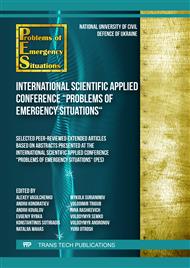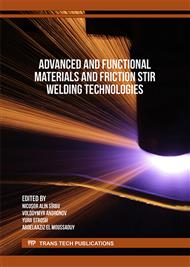[1]
On alternative energy sources: The Law of Ukraine of 20.02.2003 № 555-IV // Database «Legislation of Ukraine» / Verkhovna Rada of Ukraine. (date of application: 26.02.2023). [in Ukrainian].
Google Scholar
[2]
Arslan, U. and Huber, H. (2013). Characterization of heat transport processes in geothermal systems. Int J Low-Carbon Technol 8: 71 – 79.
DOI: 10.1093/ijlct/ctt014
Google Scholar
[3]
Lee, J. H., Hwang, K. S., Jang S. P., Lee, B. H., Kim, J. H., Choi, S. U.S. and Choi, C. J. Effective viscosities and thermal conductivities of aqueous nanofluids containing low volume concentrations of Al2O3 nanoparticles. Int J Heat Mass Transf.; 51 (2008) 2651–2656.
DOI: 10.1016/j.ijheatmasstransfer.2007.10.026
Google Scholar
[4]
Fsadni, A. M., Whitty, J. P. M., Adeniyi, A. A., Simo, J., and Brooks, H. L. A review on the application of nanofluids in coiled tube heat exchangers. J Micro Nanomanuf. 2 (2017) 443–465.
DOI: 10.1007/978-3-319-67132-1_15
Google Scholar
[5]
Sheikholeslami М., Jafaryar М., Shafee А., Li Z., Rizwan-ul Haq R. Heat transfer of nanoparticles employing innovative turbulator considering entropy generation. International Journal of Heat and Mass Transfer. 136 (2019) 1233-1240.
DOI: 10.1016/j.ijheatmasstransfer.2019.03.091
Google Scholar
[6]
Rymar, T. and Kazmiruk, M. Data analysis of the turbulent flow of nanofluids «water-Al2O3» and «water-TiO2» in the Slinky collector of the heat pump. 2022 IEEE 17th International Conference on Computer Sciences and Information Technologies (CSIT), Lviv, Ukraine, (2022), 357–360.
DOI: 10.1109/CSIT56902.2022.10000767
Google Scholar
[7]
Komeilibirjandi, A., Raffiee, A. H., Maleki, A., Alhuyi Nazari, M., and Safdari Shadloo, M. Thermal conductivity prediction of nanofluids containing CuO nanoparticles by using correlation and artificial neural network. J. Therm. Anal. Calorim. 139 (2019) 2679.
DOI: 10.1007/s10973-019-08838-w
Google Scholar
[8]
Rymar, T., Kazmiruk, M. and Shyika I. The Efficiency of Nanofluid Use in the Heat Supply System of a House with a Geothermal Heat Pump. 2021 IEEE 11th International Conference Nanomaterials: Applications & Properties (NAP), (2021).
DOI: 10.1109/NAP51885.2021.9568625
Google Scholar
[9]
Che, S., Breitenmoser, D., Infimovskiy, Y. Y., Manera, A., and Petrov, V. CFD-simulation of two-phase flows in helical coils. Front. Energy Res. 8 (65) (2020).
DOI: 10.3389/fenrg.2020.00065
Google Scholar
[10]
Naik, B. A. K., and Vinod, A. V. Heat transfer enhancement using non-Newtonian nanofluids in a shell and helical coil heat exchanger. Exp. Therm. Fluid Sci. 90 (2018) 132–142.
DOI: 10.1016/j.expthermflusci.2017.09.013
Google Scholar
[11]
Kosmadakis G., Neofytou P. Investigating the effect of nanorefrigerants on a heat pump performance and cost-effectiveness. Thermal Science and Engineering Progress 13 (2019) 100371.
DOI: 10.1016/j.tsep.2019.100371
Google Scholar
[12]
Shiravi, A. H., Shafiee, M., Firoozzadeh, M., Bostani, H., and Bozorgmehrian, M. Experimental study on convective heat transfer and entropy generation of carbon black nanofluid turbulent flow in a helical coiled heat exchanger. J. Therm. Anal. Calorim. (2020).
DOI: 10.1007/s10973-020-09729-1
Google Scholar
[13]
Noor, Shafi, Ehsan, M. M., Salehin, Sayedus, and Sadrul Islam, A. K M Heat transfer and pumping power using nanofluid in a corrugated tube. 19th Australasian Fluid Mechanics Conference, AFMC 2014, Melbourne, VIC, 8-11 December 2014. Australasian Fluid Mechanics Society.
DOI: 10.14264/3538538
Google Scholar
[14]
Wongcharee K., Eiamsa-ard S. Heat transfer enhancement by using CuO/water nanofluid in corrugated tube equipped with twisted tape. J. Int. Communications in Heat and Mass Transfer. (2012).
DOI: 10.1016/j.icheatmasstransfer.2011.11.010
Google Scholar
[15]
Routbort, J.L., Singh, D., Timofeeva, E.V., Yu.W., and France D. M. Pumping power of nanofluids in a flowing system. J Nanopart Res. 13 (2011) 931–937.
DOI: 10.1007/s11051-010-0197-7
Google Scholar
[16]
Vasylenko, S.M., Ukrainets, A.I., and Olishevsky, V.V. Basics of heat and mass transfer. Kyiv: NUKHT (2004) [in Ukrainian].
Google Scholar



